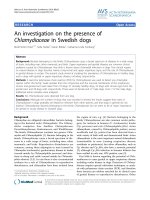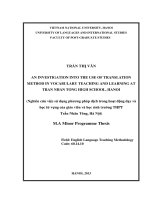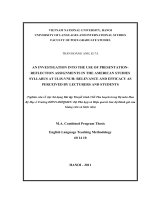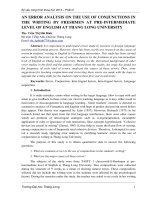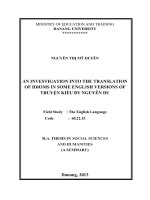an investigation on the use of pictures in teaching english vocabulary to high school students
Bạn đang xem bản rút gọn của tài liệu. Xem và tải ngay bản đầy đủ của tài liệu tại đây (756.53 KB, 54 trang )
CAN THO UNIVERSITY
SCHOOL OF EDUCATION
ENGLISH DEPARTMENT
AN INVESTIGATION ON THE USE OF PICTURES IN TEACHING ENGLISH
VOCABULARY TO HIGH SCHOOL STUDENTS
B. A Thesis
Field of study: English Language Teaching
Supervisor: Tran Thi Chau Pha, M.Ed.
Researcher: Lam Hong Chi
Code: 7086620
Class: NN0852A2
Can Tho, April 2012
An investigation on the use of pictures in teaching English vocabulary to high school students
Acknowledgements
First of all, I wish to send my deep gratitude to the English Department who gave me an
opportunity to carry out this research paper and permitted me to work with my
supervisor, Ms. Tran Thi Chau Pha.
I would like to thank all of my teachers in the English Department, Can Tho University
for their encouragements. Especially, I would like to express my special thanks to my
supervisor, Ms. Tran Thi Chau Pha, for her support and guidance throughout my thesis
writing. It is not my success without her valuable comments, suggestions and
corrections.
Besides, I am sincerely thankful to Mr. Nguyen Thien Nhiem, my supervisor for my
teaching practicum at Chau Van Liem High School and all students of the class 10A2
and 10A3 for their cooperation and assistance during my study.
In addition, I really want to send my sincere thanks to all my friends who gave me a lot
of encouragement, especially to Dao Thi Doan Trang who helped me collect the data for
this study.
Last but not least, I would love to send my special love to my family and my boyfriend
who always supported me during the time I conducted the thesis.
Your contribution is important. Thank you all for your help and support.
Lam Hong Chi.
Supervisor: Tran Thi Chau Pha
i
Lam Hong Chi-7086620
An investigation on the use of pictures in teaching English vocabulary to high school students
Abstract
Vocabulary plays an important role in learning foreign language. It supports students in
learning other skills such as reading, writing, listening and speaking. There have been
many techniques in teaching vocabulary including giving explanations, examples and
using pictures (Duong, 2005; Nation, 1990). This paper aims to study the use of pictures in
learning vocabulary to high school students. Using pictures to teach vocabulary is one of
the most popular methods used as part of learning and teaching English. Through the use
of pictures in teaching vocabulary, teachers can help their students learn new words
effectively and remember the words longer. The paper focuses on students’ attitudes and
perceptions toward using pictures in learning vocabulary and how effectively students
can learn vocabulary with pictures. The study was conducted from February to the
middle of April, 2012 in Chau Van Liem High School with the participation of 45 Grade
10 students. This was an experimental research with two instruments: a twenty-one-item
questionnaire of five-point scale to know students’ attitudes on the use of pictures in
learning vocabulary, classroom teaching and vocabulary tests. The data results from
questionnaire and tests were treated via SPSS 17.0 and Excel program. The results
showed that the students liked using pictures in learning vocabulary and had a positive
attitude towards the benefits of this technique.
Supervisor: Tran Thi Chau Pha
ii
Lam Hong Chi-7086620
An investigation on the use of pictures in teaching English vocabulary to high school students
Table of contents
Acknowledgements ..............................................................................................................i
Abstract .............................................................................................................................. ii
Table of contents ............................................................................................................... iii
List of tables...................................................................................................................... vi
List of figures .................................................................................................................... vi
CHAPTER 1: INTRODUCTION....................................................................................1
I.
Rationale ..................................................................................................................1
II.
Research aims and questions ...................................................................................2
III. Hypothesis................................................................................................................2
IV. The significance of the thesis...................................................................................2
V. Organization of the thesis ........................................................................................3
CHAPTER 2: LITERATURE REVIEW........................................................................4
I.
Vocabulary ...............................................................................................................4
1. Definition..................................................................................................................................... 4
2. The important role of vocabulary in teaching and learning English ........................... 4
3. How to make vocabulary teaching and learning effective ............................................. 5
4. Techniques in teaching English vocabulary ...................................................................... 5
II.
Pictures- an effective teaching aid of presenting new words ..................................6
1. Definition..................................................................................................................................... 6
2. Types of pictures ....................................................................................................................... 7
3. The use of pictures .................................................................................................................... 7
Supervisor: Tran Thi Chau Pha
iii
Lam Hong Chi-7086620
An investigation on the use of pictures in teaching English vocabulary to high school students
4. The advantages and disadvantages of pictures used ........................................................ 8
III. Testing......................................................................................................................9
1. The important role of testing .................................................................................................. 9
2. Vocabulary tests ...................................................................................................................... 10
IV. Related studies on the use of pictures ....................................................................11
CHAPTER 3: RESEARCH METHODOLOGY .........................................................14
I.
Research design .....................................................................................................14
II.
Participants.............................................................................................................14
III. Instruments.............................................................................................................14
1. Questionnaire ........................................................................................................................... 14
2. Vocabulary tests ...................................................................................................................... 15
IV. Research procedures................................................................................................16
1. The questionnaire .................................................................................................................... 16
2. Vocabulary tests ...................................................................................................................... 16
CHAPTER 4: DATA RESULTS AND DISCUSSION ................................................18
I. Data results .................................................................................................................18
1. Overview of questionnaire analysis .................................................................................... 18
2. Vocabulary tests analysis ...................................................................................................... 21
II. Discussion on the results of the study.......................................................................23
1. Students’ attitudes and perceptions towards using pictures in learning vocabulary
23
2. Using pictures help students learn vocabulary more effectively ................................ 24
CHAPTER 5: IMPLICATIONS, LIMITATIONS AND SUGGESTIONS ..............26
I.
Pedagogical implications .......................................................................................26
II.
Limitations .............................................................................................................27
Supervisor: Tran Thi Chau Pha
iv
Lam Hong Chi-7086620
An investigation on the use of pictures in teaching English vocabulary to high school students
III. Suggestions for further research ............................................................................27
IV. Conclusion .............................................................................................................27
REFERENCES............................................................................................................... vii
APPENDICES ...................................................................................................................x
Appendix 1 .....................................................................................................................xi
Appendix 2 ....................................................................................................................xv
Appendix 3 ...................................................................................................................xix
Supervisor: Tran Thi Chau Pha
v
Lam Hong Chi-7086620
An investigation on the use of pictures in teaching English vocabulary to high school students
LIST OF TABLES
Table 1: Clusters of the questionnaire ............................................................................ 13
Table 2: Reliability Coefficient of the questionnaire...................................................... 15
Table 3: Descriptive statistics of students’ perceptions and attitudes on the use of
pictures ............................................................................................................................ 16
Table 4: Descriptive statistics of students’ perceptions and attitudes on the use of
pictures ............................................................................................................................ 16
Table 5: The changes in some items of 2 questionnaires ............................................... 17
Table 6: The mean score of 3 vocabulary tests............................................................... 18
LIST OF FIGURES
Figure 1: The mean score of pre and post-questionnaire................................................ 17
Figure 2: Percentage of marks in the first test ................................................................ 19
Figure 3: Percentage of marks in the second test............................................................ 19
Figure 4: Percentage of marks in the third test ............................................................... 20
Supervisor: Tran Thi Chau Pha
vi
Lam Hong Chi-7086620
An investigation on the use of pictures in teaching English vocabulary to high school students
REFERENCES
Andrew, W. (Ed.). (1989). Picture for language learning. Cambridge: Cambridge
University Press.
Azlina Yunus, N. (Ed.). (1981). Preparing and using aids for English Language
Teaching. Kuala Lumpur: Oxford University Press.
Baumann, J. F., Kame‘enui, E. J., & Ash, G. E. (2003). Research on vocabulary
instruction: Voltaire redux. Handbook of Research on Teaching the English
Language Arts, 752-785
Becker, W. C. (1977). Teaching reading and language to the disadvantaged – What we
have learned from field research. Harvard Educational Review, 47, 518-543.
Bloomfield, L. (Ed.). (1993). Language. London:Allen & Unwin.
Carter, R. (Ed.). (1998). Vocabulary: applied linguistic perspectives. New York:
Routledge.
Davis, F. B. (1942). Two new measures of reading ability. Journal of Educational
Psychology, 33, 365-372.
Duong, O. (Ed.). (2005). English teaching methodology: teaching the what. Can tho: Can
Tho university
Shinta, E.P. (2006). Teaching English vocabulary by using pictures and songs to young
learners at TK Kalpataru Bintaro. Gunadarma University.
Gairns, R., & Redman, S. (Eds.). (1992). Working with words: a guide to teaching and
learning vocabulary. Cambridge: Cambridge University Press.
George, D., & Mallery, P. (Eds.). (2003). SPSS for windows step by step: a simple guide
and reference (fourth ed.). Boston: Allyn & Bacon.
Gerlach, V., & Emily, D. (Eds.). (1980). Teaching and Media a Systematic Approach
(second ed.). New Jersey: Prentice Hall.
Supervisor: Tran Thi Chau Pha
vii
Lam Hong Chi-7086620
An investigation on the use of pictures in teaching English vocabulary to high school students
Greenwood, S. C. (2002). Making words matter: Vocabulary study in the content areas.
The Clearing House, 75, 258-263.
Harmer, J. (Ed.). (1993). The practice of English language teaching (third ed.): Longman
group UK limited.
Harmer, J. (Ed.). (2001). The practice of English language teaching (third ed.). London:
Longman.
Hatch, E., & Brown, C. (Eds.). (1995). Vocabulary, semantics and language education.
Cambridge: Cambridge University Press.
Hill, D. A. (Ed.). (1990). Visual impact: Creative language learning through pictures:
Essex: Longman Group UK Limited.
Joklova, K. (2009). Using pictures in teaching vocabulary to primary school children.
Masaryk.
Joklová, K. (2009). Using pictures in teaching vocabulary to children at primary school.
Masaryk University
Leny, N. (2006). Teaching vocabulary through pictures to the kindergarten students.
Jakarta: Islamic University.
Madsen, H. S. (Ed.). (1983). Techniques in testing (first ed.). New York: Oxford
University Press.
Mc Carthy, M. (Ed.). (1992). Vocabulary. Oxford: Oxford University Press.
Mckenkchnie, L. (Ed.) (1980) Webster new twentieth century dictionary unabridge
(second ed.). William Collins Publisher
Betty, M.B. (1973). Look Here!, Visual Aids In Language Teaching. London: essential
language- Teach Series, 13- 31.
Nation, I. S. P. (Ed.). (1990). Teaching and learning vocabulary. New York: Heinle &
Heinle.
Nattinger, J. (Ed.). (1988). Some current trends in vocabulary teaching. London:
Longman.
Supervisor: Tran Thi Chau Pha
viii
Lam Hong Chi-7086620
An investigation on the use of pictures in teaching English vocabulary to high school students
Nguyen, T. (2010). Atttidudes and perceptions of high school students and teachers on
the use of eliciting techiniques in English vocabulary lessons. Can Tho: Can Tho
University.
Nunnally, J. C. (Ed.). (1978). Psychometric theory (second ed.). New York: McGrawHill.
Pressley, M. (1977). Pictures, partial picture, and young children's partial prose learning.
Journal of educational psychology. 69, 473-480.
Samuels, S. J. (1970). Effects of pictures on learning to read, comprehension and
attitudes. Review of educational research, 40, 397-407.
Saville, M., & Troike, M. (1984). What really matters in second language learning for
academic achievement. TESOL Quarterly, 199-219.
Szyke, B. (Ed.). (1981). Using pictures as teaching aids (Vol. XIX): English teaching
forum
Thornbury, S. (Ed.). (2004). How to teach vocabulary: Essex: Pearson Education
Limited.
Whipple, G. (Ed.). (1925). The twenty-fourth yearbook of the national society for the
study of education: report of the national committee on reading. Bloomington:
Public school publishing.
Wilkins, D. (Ed.). (1972). Linguistics in language teaching. London: Edward Arnold.
Wright, A. (Ed.). (1990). Pictures for Language Learning. Cambridge: Cambridge
University Press.
Wright, A., & Haleem, S. (Eds.). (1996). Visuals for the language classroom: Longman
group UK limited.
Supervisor: Tran Thi Chau Pha
ix
Lam Hong Chi-7086620
An investigation on the use of pictures in teaching English vocabulary to high school students
APPENDICES
Supervisor: Tran Thi Chau Pha
x
Lam Hong Chi-7086620
An investigation on the use of pictures in teaching English vocabulary to high school students
Appendix 1
QUESTIONNAIRE
Dear students,
This research is designed to explore the use of pictures in teaching English vocabulary to high school students. Your
answer will be very helpful and highly appreciated for an important section in my Bachelor of Art thesis. This information
you provide is only used for this research and known by the researcher and her supervisor. There is no right or wrong
answer in this questionnaire. So, feel free to give your opinions for 21 statements in the questionnaire within about 10-15
minutes.
Please first give your personal information by filling in the following blanks and putting a tick () in one box that
corresponds to your gender, and then complete the rest of the survey.
PART A: BACKGROUND
Name:…………………………………
Class:………………………………….
Gender:
female
Supervisor: Tran Thi Chau Pha
male
xi
Lam Hong Chi-7086620
An investigation on the use of pictures in teaching English vocabulary to high school students
PART B: ATITUDES AND PERCEPTIONS ON THE USE OF PICTURES IN TEACHING VOCABULARY
For each statement, please read and indicate to what extent you agree or disagree by ticking on a 5-point scale from (1)
“strongly disagree” to (5) “strongly agree”. In each row, tick () ONE cell only
Number
1.
Statements
A large amount of vocabulary is the key to
Strongly
Neutral
1
2
3
4
5
1
2
3
4
5
1
2
3
4
5
1
2
3
4
5
1
2
3
4
5
disagree
agree
Strongly
disagree
agree
success.
2.
I like my teacher to use pictures to teach
new words.
3.
Knowing new words helps me much in
reading, writing, listening and speaking.
4.
I prefer being taught new vocabulary by
using pictures.
5.
When my teacher uses pictures, I can guess
the meaning of new words easily.
6.
I have a positive attitude towards pictures.
1
2
3
4
5
7.
Pictures make me actively be involved in
1
2
3
4
5
1
2
3
4
5
learning process.
8
I like my teacher to use pictures in teaching
Supervisor: Tran Thi Chau Pha
xii
Lam Hong Chi-7086620
An investigation on the use of pictures in teaching English vocabulary to high school students
new vocabulary
9.
Learning new vocabulary by pictures, I can
1
2
3
4
5
1
2
3
4
5
1
2
3
4
5
1
2
3
4
5
1
2
3
4
5
1
2
3
4
5
1
2
3
4
5
1
2
3
4
5
remember the words longer.
10.
I feel bored when my teacher uses pictures
to teach new words
11.
After the teacher elicits new words by
pictures, I feel stressful when the teacher
asks me to guess the meaning.
12.
Learning vocabulary by pictures helps me
develop my guessing meaning ability.
13.
Pictures make me pay attention to the
lesson and make me think more.
14.
I feel frustrated when I cannot find a
correct answer although my teacher uses
pictures and explains them.
15.
Pictures delight class and make me more
active.
16.
I
sometimes
cannot
understand
my
teacher’s pictures and explanations.
Supervisor: Tran Thi Chau Pha
xiii
Lam Hong Chi-7086620
An investigation on the use of pictures in teaching English vocabulary to high school students
17.
After studying new words with pictures, I
1
2
3
4
5
1
2
3
4
5
1
2
3
4
5
can remember and apply about 80%.
18.
Pictures give me the motivating feeling to
express my opinion and contribute some of
my knowledge.
19.
Using pictures in teaching vocabulary will
make my class more interesting.
20.
Pictures help me increase my vocabulary.
1
2
3
4
5
21.
When I learn vocabulary with pictures, I
1
2
3
4
5
always focus on the pictures and ignore
their meaning.
Thank you for your contribution.
If you would like to know more about my thesis, or if you have questions or suggestions about it, please email:
Supervisor: Tran Thi Chau Pha
xiv
Lam Hong Chi-7086620
An investigation on the use of pictures in teaching English vocabulary to high school students
Appendix 2
BẢNG CÂU HỎI
Các bạn học sinh thân mến,
Đây là một bài nghiên cứu nhỏ được thực hiện nhằm tìm ra tác dụng của hình ảnh trong việc dạy từ vựng tiếng Anh. Những
câu trả lời của các bạn sẽ rất có giá trị đối với phần phân tích số liệu trong bài luận văn tốt nghiệp của tôi. Dữ liệu thu thập
được chỉ dùng cho mục đích nghiên cứu. Câu trả lời và thơng tin cá nhân của các bạn sẽ được bảo mật. Hoàn tồn khơng có
câu trả lời đúng hay sai trong bảng câu hỏi nghiên cứu này. Vì vậy, các bạn có thể thoải mái thể hiện suy nghĩ của mình về
21 ý kiến được nêu trong bảng nghiên cứu này trong vịng 10-15 phút.
Trước hết, vui lịng cung cấp vài thơng tin về bạn bằng cách điền vào khoảng trắng bên dưới và đánh dấu () vào ơ ứng với
giới tính của bạn trước khi hoàn thành bảng câu hỏi nghiên cứu.
PHẦN A: THƠNG TIN CÁ NHÂN
Tên:………………………………….
Tuổi:………………………………...
Lớp: …………………………….…..
Giới tính:
Nam:
Supervisor: Tran Thi Chau Pha
Nữ:
xv
Lam Hong Chi-7086620
An investigation on the use of pictures in teaching English vocabulary to high school students
PHẦN B: QUAN ĐIỂM VỀ HÌNH ẢNH TRONG VIỆC DẠY VÀ HỌC TỪ VỰNG TIẾNG ANH.
Cho mỗi câu, vui lòng cho biết mức độ đồng ý hoặc không đồng ý của bạn dựa trên 5 mức độ được đưa ra từ (1) “hồn
tồn khơng đồng ý” đến (5) “hoàn toàn đồng ý”. Chỉ đánh dấu ( ) vào MỘT ơ cho mỗi câu.
Hồn tồn
STT
Ý kiến
khơng đồng
ý
1.
Một số lượng lớn từ vựng là chìa khóa
Khơng
Khơng có ý
đồng ý
kiến
Đồng ý
Hồn tồn
đồng ý
1
2
3
4
5
1
2
3
4
5
1
2
3
4
5
1
2
3
4
5
1
2
3
4
5
1
2
3
4
5
1
2
3
4
5
của sự thành cơng.
2.
Tơi thích giáo viên của tôi sử dụng tranh
ảnh để dạy từ mới.
3.
Biết nhiều từ mới sẽ giúp tơi nhiều trong
nghe, nói, đọc, viết.
4.
Tơi thích được dạy từ mới bằng tranh ảnh
hơn là các kỷ xảo khác.
5.
Khi giáo viên của tôi sử dụng tranh ảnh,
tơi có thể đốn nghĩa của từ mới một cách
dễ dàng.
6.
Tơi có một thái độ tích cực đối với dạy từ
vựng bằng tranh ảnh.
7.
Tranh ảnh làm cho tôi hăng hái trong quá
Supervisor: Tran Thi Chau Pha
xvi
Lam Hong Chi-7086620
An investigation on the use of pictures in teaching English vocabulary to high school students
trình học.
8
Tơi thích giáo viên sử dụng tranh ảnh đa
1
2
3
4
5
1
2
3
4
5
1
2
3
4
5
1
2
3
4
5
1
2
3
4
5
1
2
3
4
5
1
2
3
4
5
1
2
3
4
5
1
2
3
4
5
dạng trong dạy từ vựng.
9.
Học từ với tranh ảnh giúp tôi nhớ từ lâu
hơn.
10.
Tôi cảm thấy nhàm chán khi giáo viên sử
dụng tranh ảnh để dạy từ mới.
11.
Sau khi giáo viên gợi ý từ bằng tranh ảnh,
tôi cảm thấy áp lực khi giáo viên u cầu
tơi đốn nghĩa.
12.
Học từ mới bằng tranh ảnh giúp tôi phát
triển khả năng đoán nghĩa từ vựng.
13.
Học từ vựng bằng tranh ảnh giúp tôi chú
tâm và suy nghĩ đến bài học.
14.
Tôi cảm thấy nản khi khơng thể tìm ra
câu trả lời mặc dù giáo viên đã sử dụng
tranh ảnh và giải thích.
15.
Tranh ảnh làm vui lớp học và làm cho tôi
năng động hơn.
16.
Thỉnh thoảng tôi không thể hiểu được
tranh ảnh và giải thích của giáo viên.
Supervisor: Tran Thi Chau Pha
xvii
Lam Hong Chi-7086620
An investigation on the use of pictures in teaching English vocabulary to high school students
17.
Sau khi học từ vựng với tranh ảnh, tơi có
1
2
3
4
5
1
2
3
4
5
1
2
3
4
5
thể nhớ và áp dụng khoảng 80 %
18.
Tranh ảnh cho tơi động lực để trình bày ý
kiến và đóng góp kiến thức cho bài học.
19.
Sử dụng tranh ảnh làm cho lớp tơi thích
thú hơn.
20.
Tranh ảnh giúp làm tăng vốn từ của tôi.
1
2
3
4
5
21.
Khi tôi học từ vựng với tranh ảnh, tôi chỉ
1
2
3
4
5
chú ý tới tranh mà không để ý đến nghĩa
của từ.
Cám ơn các bạn đã tham gia trả lời các câu hỏi nghiên cứu.
Nếu các bạn muốn biết thêm thông tin về đề tài luận văn của tơi, hoặc có câu hỏi hay góp ý liên quan thì vui lịng liên
hệ email:
Supervisor: Tran Thi Chau Pha
xviii
Lam Hong Chi-7086620
An investigation on the use of pictures in teaching English vocabulary to high school students
Appendix 3
VOCABULARY TESTS
TEST 1
PHẦN A: THÔNG TIN CÁ NHÂN
Tên:………………………………….
Tuổi:………………………………...
Lớp: …………………………….…..
Giới tính:
Nam:
Nữ:
PHẦN B: VOCABULARY TEST
Bài kiểm tra gồm 8 câu tất cả. Trong mỗi câu có 4 sự lựa chọn nhưng chỉ có MỘT đáp án đúng. Vui lòng khoanh tròn vào
phương án mà bạn cho là đúng.
1. One part of a film in which the events happen in one play. It is…………..
A. view
B. setting
C. scene
D. scenery
2. In the film “Titanic”, Jack and Rose are the main………………………
A. characters
Supervisor: Tran Thi Chau Pha
B. actors
C. actresses
xix
D. actor and actress
Lam Hong Chi-7086620
An investigation on the use of pictures in teaching English vocabulary to high school students
3. She learned very………………and was soon the best in the class.
A. slowly
B. badly
C. rapidly
D. easily
C. quiet
D. passive
C. film
D. play
4. He doesn’t move. He is…………………
A. still
B. silent
5. A……………..is an ordered list of objects or events.
A. story
B. sequence
6. The people who are very important in making a film. They are………….
A. producers
B. actors
C. directors
D. film makers
7. A decade is a period of………….years.
A. 5
B. 10
C. 50
D. 100
8. The person who acts a role of a film or a play. He is a (an)……………
A. character
Supervisor: Tran Thi Chau Pha
B. actor
C. director
xx
D. roller
Lam Hong Chi-7086620
An investigation on the use of pictures in teaching English vocabulary to high school students
TEST 2
PHẦN A: THÔNG TIN CÁ NHÂN
Tên:………………………………….
Tuổi:………………………………...
Lớp: …………………………….…..
Giới tính:
Nam:
Nữ:
PHẦN B: VOCABULARY TEST
Bài kiểm tra gồm 11 câu tất cả. Trong mỗi câu có 4 sự lựa chọn nhưng chỉ có MỘT đáp án đúng. Vui lòng khoanh tròn
vào phương án mà bạn cho là đúng.
1. She likes watching movies and going out with her friends to……………….at the weekend.
A. make friends
B. stay healthy
C. play
D. entertain
2. Wedding songs make the wedding party more…………….and happy.
A. joyful
Supervisor: Tran Thi Chau Pha
B. mournful
C. sad
xxi
D. funny
Lam Hong Chi-7086620
An investigation on the use of pictures in teaching English vocabulary to high school students
3. Roses can be used to………………….love.
A. tell
B. talk
C. express
D. inform
4. He was very kind to us so when he died we all attended his…………………..
A. party
B. funeral
C. death
D. anniversary
C. glad
D. cheerful
5. It was a…………………….day in his life when his mother died.
A. mournful
B. happy
6. People play rock songs to make the………………………cheerful and rousing.
A. earth
B. atmosphere
C. mood
D. air
C. sad
D. delightful
7. His funeral was held in a……………………..manner.
A. solemn
B. rousing
8. Human being has 5……………..They are sight, hearing, taste, smell and touch.
A. emotions
B. senses
C. organs
D. body parts
C. please
D. enjoy
9. Comedies…………………………us after a hard-working day.
A. delight
B. interest
10. He…………………….his enthusiasm to everybody.
Supervisor: Tran Thi Chau Pha
xxii
Lam Hong Chi-7086620
An investigation on the use of pictures in teaching English vocabulary to high school students
A. reflects
B. delivers
C. communicates
D. tells
C. wake
D. lull
11. The mother sings a song to…………………….the baby.
A. sleep
Supervisor: Tran Thi Chau Pha
B. get up
xxiii
Lam Hong Chi-7086620
An investigation on the use of pictures in teaching English vocabulary to high school students
TEST 3
PHẦN A: THÔNG TIN CÁ NHÂN
Tên:………………………………….
Tuổi:………………………………...
Lớp: …………………………….…..
Giới tính:
Nam:
Nữ:
PHẦN B: VOCABULARY TEST
Bài kiểm tra gồm 8 câu tất cả. Trong mỗi câu có 4 sự lựa chọn nhưng chỉ có MỘT đáp án đúng. Vui lòng khoanh tròn vào
phương án mà bạn cho là đúng.
1. “Romeo and Juliet” is a…………..written early in the career of play write William Shakespeare.
A. film
C. tragedy
B. comedy
D. tragic-comedy
2. ………….is a large commercial ship, especially one carrying passenger on a regular route.
A. boat
B. liner
C. canoe
D. ferry
3. Earthquake, flood and hurricane cause a lot of damage for human being. They are natural……………
A. dangers
Supervisor: Tran Thi Chau Pha
B. hazards
C. risks
xxiv
D. disasters
Lam Hong Chi-7086620

